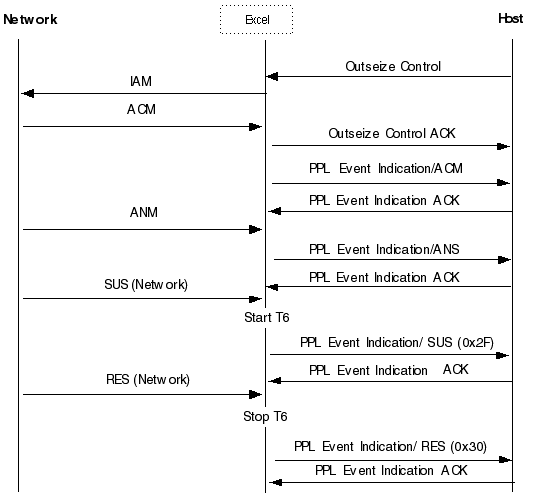
You are here: CSP Developerís Guide: Common Channel Signaling†>†4 SS7 Call Control for ISUP †>†Suspend/Resume

Overview
This section includes information and call flows about the ISUP Suspend and Resume messages.
The Suspend (SUS) message indicates a temporary cessation of communication without releasing the call. SUS can only be accepted in an answered state (ICC answered/OGC answered).
A Resume (RES) message indicates a request to recommence communication. If the RES is not sent within timer T6 or T2 (T2 applies to ITU only), the controlling exchange will initiate a release procedure.
PPL Information
The SUS and RES messages are passed in the PPL Event Request and PPL Event Indication messages, with the following Event ID values:
|
0x2D |
SUS |
|
0x2E |
RES |
For ANSI, only network-initiated SUS/RES are allowed. Only called party can send SUS. For ITU, both user and network-initiated SUS/RES are supported. Both calling and called party can initiate SUS.
Atomic function (104) in the ISUP CPC component checks for network- or user-initiated SUS/RES.
Host-Initiated
L3P CIC passes the SUS request from the host to CPC, upon which CPC enters the suspended state and waits for a RES request to recommence the communication. L3P CIC forwards the RES request from the host to CPC and CPC returns to the answered state. If the RES is not received within the resume wait timer, the call is released.
When a SUS is received from the network, CPC enters the suspended state and waits for a RES. When a RES is received from the network, CPC returns to the answered state. If the timer initiated at the controlling exchange expires before RES is received, REL is initiated.
PPL event indications include data in SS7 Raw ICB format. If the SUS/RES is not received with the valid indicator, a PPL Event Indication message indicating the error is sent to the host.
Use the PPL configuration bytes in the L3P CIC component to modify the handling of the SUS and RES messages.
The table below shows the L3P CIC PPL Configuration Bytes used to configure the SUS message for ITU.
|
Byte |
Description |
Value |
|---|---|---|
|
485 |
Information Length |
0x05 |
|
486 |
Message ID |
0x0D |
|
487 |
Number Of Parameters |
0x01 |
|
488 |
Parameter1 ID |
0x22 (Suspend/Resume indicator) |
|
489 |
Parameter Data Length |
0x01 |
|
490 |
Parameter value |
0x01 (Network Initiated) |
The table below shows the L3P CIC PPL Configuration Bytes used to configure the SUS message for ANSI.
|
Byte |
Description |
Value |
|---|---|---|
|
480 |
Information Length |
0x05 |
|
481 |
Message ID |
0x0D |
|
482 |
Number Of Parameters |
0x01 |
|
483 |
Parameter1 ID |
0x22 (Suspend/Resume indicator) |
|
484 |
Parameter Data Length |
0x01 |
|
485 |
Parameter value |
0x01 (Network Initiated) |
The table below shows the L3P CIC PPL Configuration Bytes used to configure the RES message for ITU.
|
Byte |
Description |
Value |
|---|---|---|
|
492 |
Information Length |
0x05 |
|
493 |
Message ID |
0x0E |
|
494 |
Number Of Parameters |
0x01 |
|
495 |
Parameter1 ID |
0x22 (Suspend/Resume indicator) |
|
496 |
Parameter Data Length |
0x01 |
|
497 |
Parameter value |
0x01 (Network Initiated) |
The table below shows the L3P CIC PPL Configuration Bytes used to configure the RES message for ANSI.
|
BYTE |
Description |
Value |
|---|---|---|
|
490 |
Information Length |
0x05 |
|
491 |
Message ID |
0x0E |
|
492 |
Number Of Parameters |
0x01 |
|
493 |
Parameter1 ID |
0x22 (Suspend/Resume indicator) |
|
494 |
Parameter Data Length |
0x01 |
|
495 |
Parameter value |
0x01 (Network Initiated) |
This section includes call flows showing the Suspend and Resume messages
.

